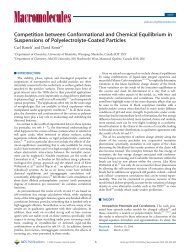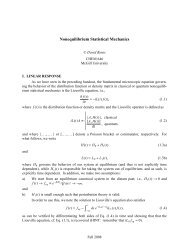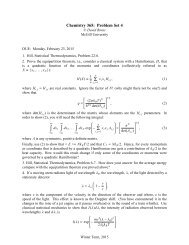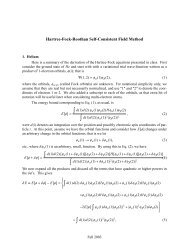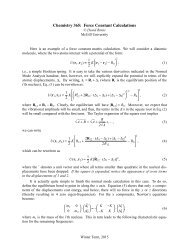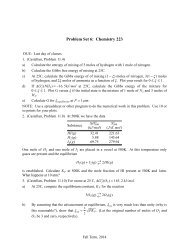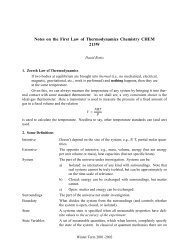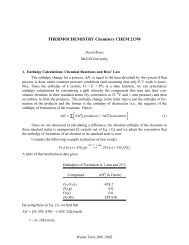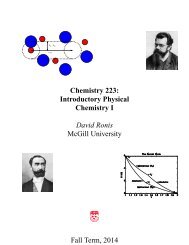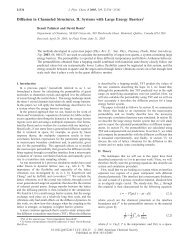Thermodynamic Stability: Free Energy and ... - McGill University
Thermodynamic Stability: Free Energy and ... - McGill University
Thermodynamic Stability: Free Energy and ... - McGill University
Create successful ePaper yourself
Turn your PDF publications into a flip-book with our unique Google optimized e-Paper software.
<strong>Free</strong> <strong>Energy</strong> -8- Chemistry 223<strong>and</strong>⎛ ∂ 2 G ⎞>0. (24)⎝ ∂ξ 2 ⎠ T ,P,NtotalBy using the differential form for the change in the free energy together with Eq. (22) we findthatwhich when used in Eq. (23) givesdG =−SdT + VdP + Σ rν i µ i dξ , (25)∆G ≡ ⎛ ∂G ⎞⎝ ∂ξ⎠ T ,P,Ntotali=1= rΣ ν i µ i = 0 (26)at equilibrium. ∆G is called the reaction Gibbs free energy. Since the µ i are the partial molarGibbs free energies, Eq. (26) is equivalent to ∆G = 0. At equilibrium the free energy changein the reaction per mole vanishes. (Indeed, this is the principle we applied in the "reaction"between graphite <strong>and</strong> diamond). From the definition of the Gibbs free energy (G = H -TS), it followsthati=1at equilibrium.∆S = ∆H TWhat happens if we change temperature or pressure by a small amount? Which way willthe equilibrium shift? To answer this, first note the following Maxwell relations:⎛ ∂µ i ⎞⎝ ∂T⎠ P,N j=− ⎛ ∂S ⎞=−S⎝ ∂N i ⎠ i (27a)P,T ,N j≠i<strong>and</strong>⎛ ∂µ i ⎞⎝ ∂P⎠ T ,N j= ⎛ ∂V ⎞= V⎝ ∂N i ⎠ i (27b)P,T ,N j≠iwhich follow from the Gibbs free energy. Thus the changes in the chemical potential associatedwith temperature or pressure are related to the partial molar entropies or volumes, respectively.Next consider⎛ ∂µd( Σν i µ i ) =i ⎞⎛ ∂µΣν i dT +i ⎞Σν⎝ ∂T ⎠ i dP + ⎛ ∂(Σν i µ i ) ⎞dξP,N j⎝ ∂P ⎠ T ,N j⎝ ∂ξ ⎠ T ,P,Ntotaliii=−∆SdT +∆VdP + ⎛ ∂∆G ⎞dξ , (28)⎝ ∂ξ ⎠ T ,P,Ntotalwhere, cf. Eqs. (27), ∆S ≡ Σν i S i <strong>and</strong> ∆V ≡ Σν i V i are the entropy <strong>and</strong> volume changes per moleof reaction. Equation (28) shows how the free energy change per mole of reaction changes whenwe change T, P,or ξ .What happens if we change, T or P in a system where chemical reaction is possible? Theprogress variable will change until Eq. (26) is again valid. Since both the initial <strong>and</strong> final statesFall Term, 2014




